In the summer of 2020, conservation biologists discovered more than 350 savannah (bush) elephant (Loxodonta africana) carcasses scattered around the north region of Botswana’s Okavango Delta. These iconic mammals appeared to have collapsed and died suddenly.
After several months of confusion and concern surrounding the cause of death, the Botswana government announced that the mass die-off occurred as a result of drinking contaminated water. The waterholes from which the elephants drank appeared to have been tainted by cyanobacteria, a type of algae that can sometimes be toxic to animals and people.
In July 2022, Scripps Oceanography chemical oceanographer Lihini Aluwihare flew to Botswana to collect water samples in a search for more answers on these mysterious mass deaths. During her ten-day long expedition, known as CHABO (Cyanobacteria Harmful Algal Blooms in the Okavango), she traveled to remote waterholes by helicopter, collecting samples to evaluate the presence of toxic cyanobacteria.
Aluwihare grew up near the Botswana region and said she has always wanted to go back to Africa to do work that is relevant to her and African communities.
“Being an oceanographer, it has been difficult finding work in the region around Zambia where I grew up, because Zambia and its close neighbors, like Botswana, are landlocked,” said Aluwihare. “However, once I heard about the potential for harmful algal blooms, I knew my skill set and expertise from working in the ocean could be applied in this situation.”
The following photo essay outlines Aluwihare and her team’s expedition in Botswana. Her goal is to eventually set up a long-term monitoring program that tracks how the interaction between the elephants and their water resources might evolve over time.
“This research is so important because we are trying to understand how the impact of climate on these water resources has a downstream effect on wildlife in southern Africa,” said Aluwihare. “These are amazing animals, and all the species served by this region are worthy of protection and preservation, so doing this work is crucial.”
This research was made possible by veterinarians Dr. Comfort Nkgowe and Dr. Wave Kashweka at the Department of Wildlife and National Parks, Botswana, researchers Dr. Mosimanegape Jongman and Kenosi Kebabonye from the University of Botswana, Gaborone, and Dr. Mangaliso Gondwe and Kaelo Makati from the Okavango Research Institute.
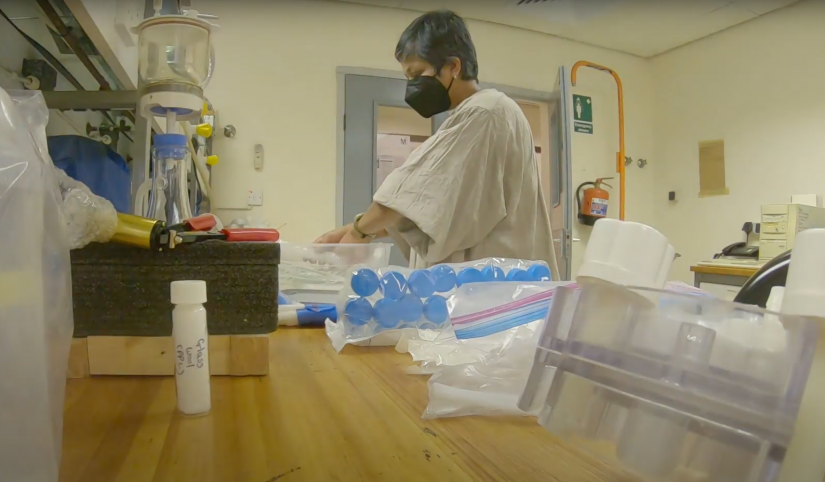
Day 1. Lihini Aluwihare (Scripps Oceanography) in the lab at the Okavango Research Institute, unpacking all the “goodies" she sent ahead and trying to keep busy while anxiously waiting to hear if the team could get chopper access to the study region.
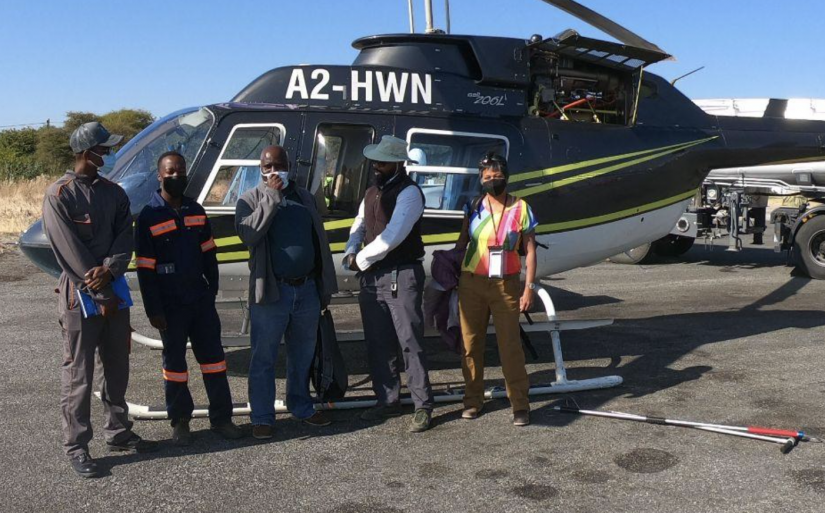
The field team getting ready to head out to the sampling sites. Left to right: Dr. Wave Kashweka (veterinarian with the Ministry of Wildlife and National Parks; accompanying the team as an observer to ensure they followed proper protocols), Kenosi Kebabonye, Dr. Mangaliso Gondwe, Kaelo Makati, and Lihini Aluwihare (Scripps Oceanography).
Getting the team together on Day 1 at the Okavango Research Institute in Maun. Kenosi Kebabonye, Dr. Mangaliso Gondwe, Kaelo Makati and Dr. Mosimanegape "Gape" Jongman all donated their time to this trip.
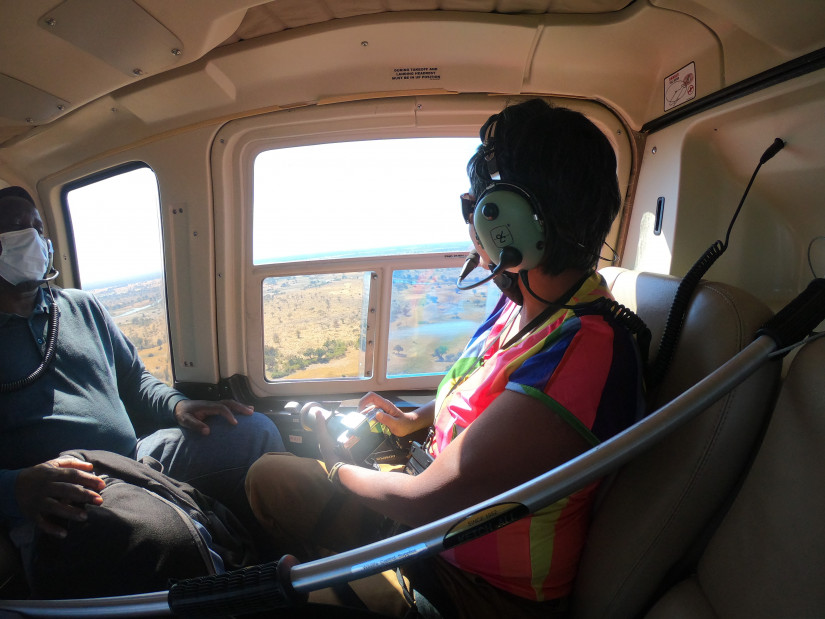
Lihini Aluwihare (Scripps Oceanography) and Dr. Mangaliso Gondwe (Okavango Research Institute, University of Botswana) en route from Maun to the study site. The team is flying over the Okavango Delta on a Helicopter Horizons charter that was supported by the Ministry of Wildlife and National Parks, Botswana. The pole is a dog catcher that they improvised into a water sampling pole.
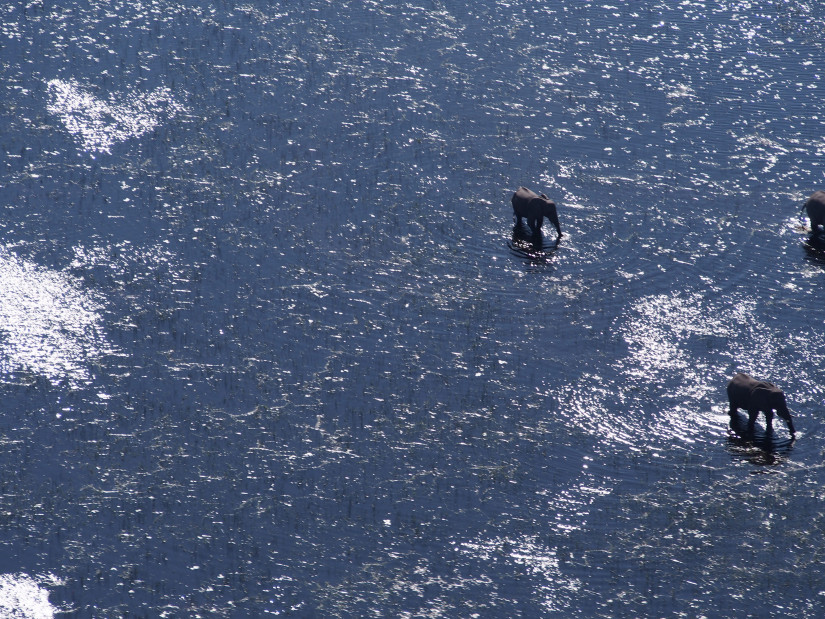
As the Okavango Delta fills, animals come from far and wide to feast and drink. Lihini Aluwihare (Scripps Oceanography) captured this herd of elephants wading in one of the delta’s waterways as she was flying above, heading to the study site.
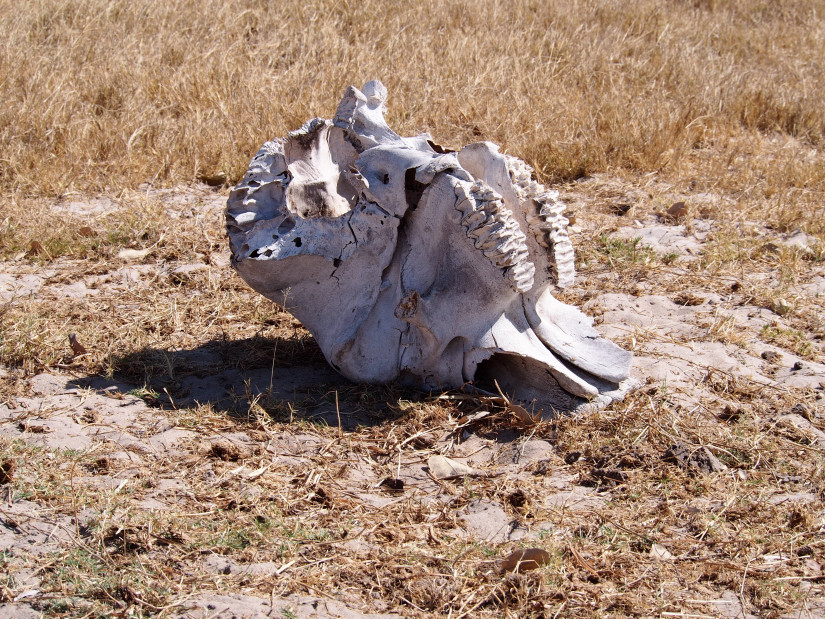
An elephant skull found close to one of the study sites. The cause of death is unclear but may have been part of the 2020 mortality event.
Kenosi Kebabonye (MSc student at University of Botswana, Gaborone), Kaelo Makati (Okavango Research Institute, out of photo) and Lihini Aluwihare (Scripps Oceanography), sampling from their makeshift “pole sampler” fashioned from a bucket and dog catcher (which they were prepared to use as a crocodile catcher if the need arose) purchased at the local hardware store in Maun. The turbidity of this sample was typical of what they dealt with because these waterholes were drying out rapidly. Turbid samples present unique challenges for filtering and analysis.
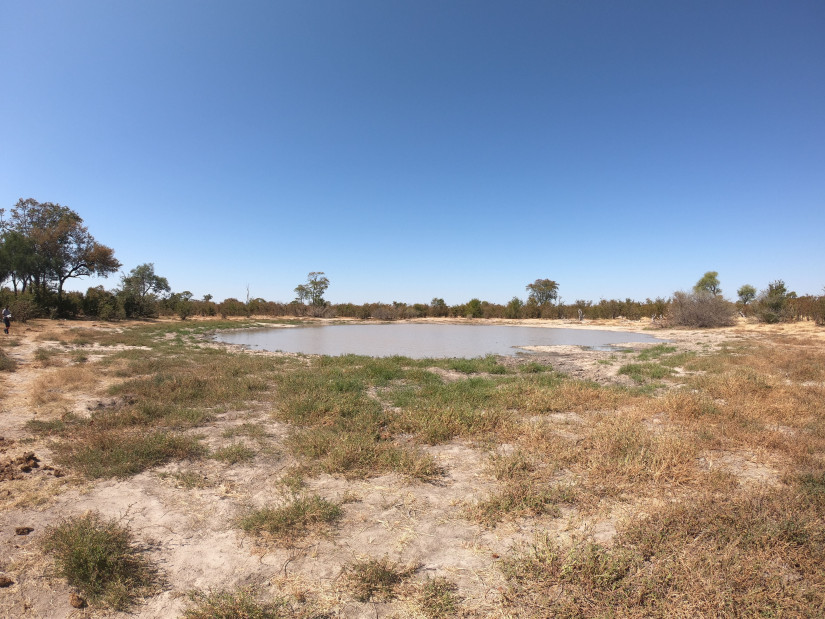
This ephemeral pan was one of the team’s control sites and was more full than most that the team sampled. Ephemeral pans are depressions in the ground that over the years have become very small ponds that fill seasonally. These are the main sources of water outside the Okavango Delta. This is the dry season in Botswana when rain-fed water pans are drying out rapidly.
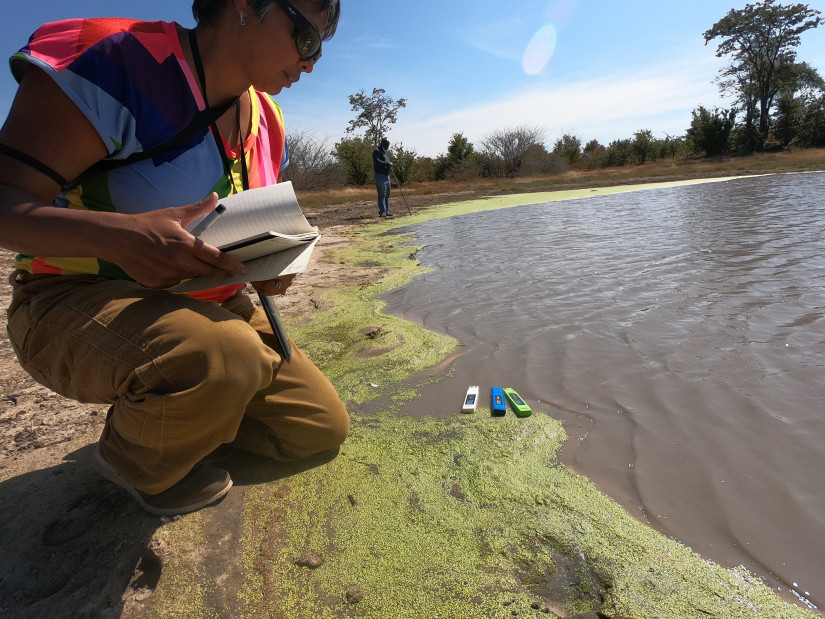
The team had to improvise in the field with what they had. These are simple battery operated pH, temperature, and conductivity meters. The vegetation at this control pan was quite different from where mass mortality in 2020 was recorded. In the background, Dr. Gondwe is using an auger to take some small sediment cores.
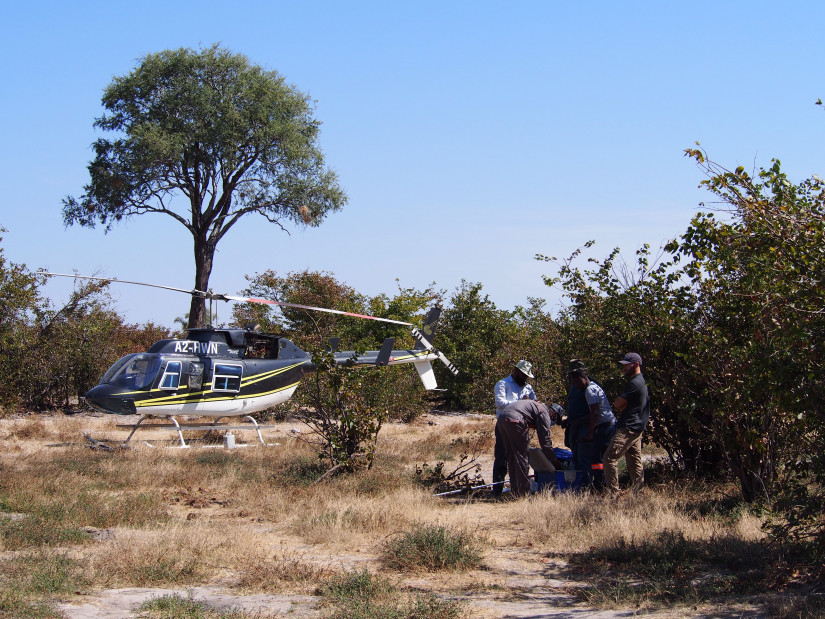
The team was lucky to find a water pan in the region of densest mortality in 2020, that still had water following the 2022 rains. Most of the team is in this picture getting ready to sample: Kaelo Makati (ORI, hat), Dr. Wave Kashweka (Vet, Ministry of Wildlife and National Parks; bending over the cooler), Kenosi Kebabonye (MSc student at University of Botswana, second from right) and the pilot from Helicopter Horizons. Before the trip, they had to secure a sampling permit and permission from the Ministry, and Dr. Kashweka was present as an observer. “As would be expected, Dr. Kashweka’s knowledge of the region was invaluable,” said Lihini Aluwihare. “His recounting of the scene on the ground in 2020 was haunting.”
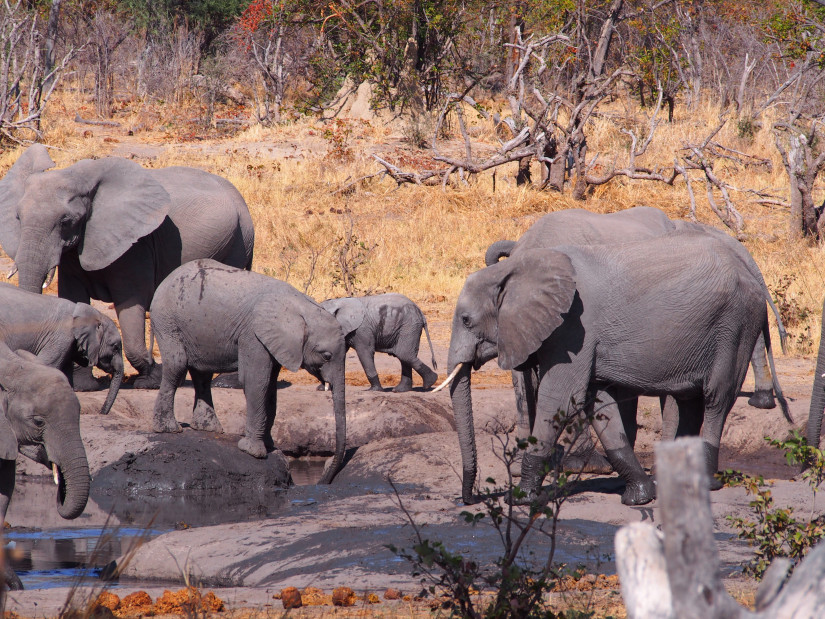
Lihini Aluwihare (Scripps Oceanography) had one afternoon to explore the National Park closest to Maun known as Moremi Game Reserve. She managed to catch some glimpses of elephants at the reserve, where the matriarchs rule the herd.
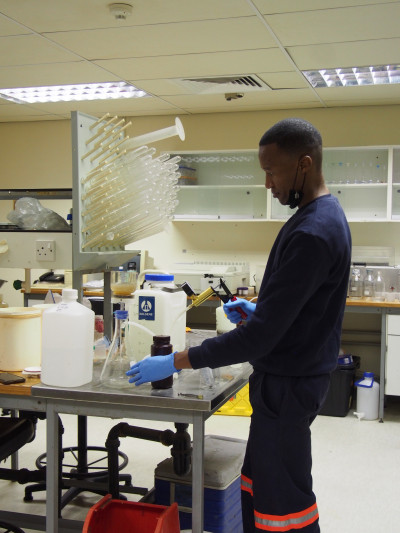
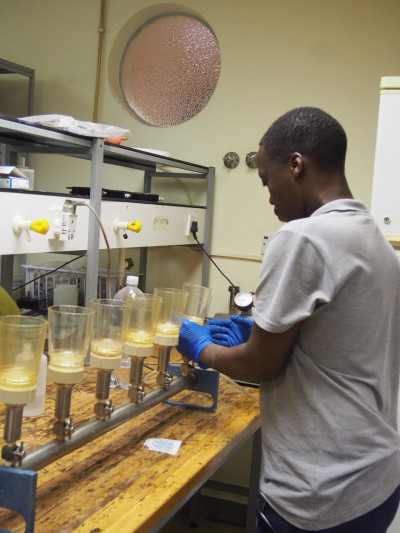
Dr. Mosimanegape Jongman (left) and MSc student Kenosi Kebabonye (right) from the University of Botswana, Gaborone, processing samples back at the lab at the Okavango Research Institute. They had some very long days in the lab and only Amapiano to keep them going. “Amapiano is the best house music in the world,” said Lihini Aluwihare.
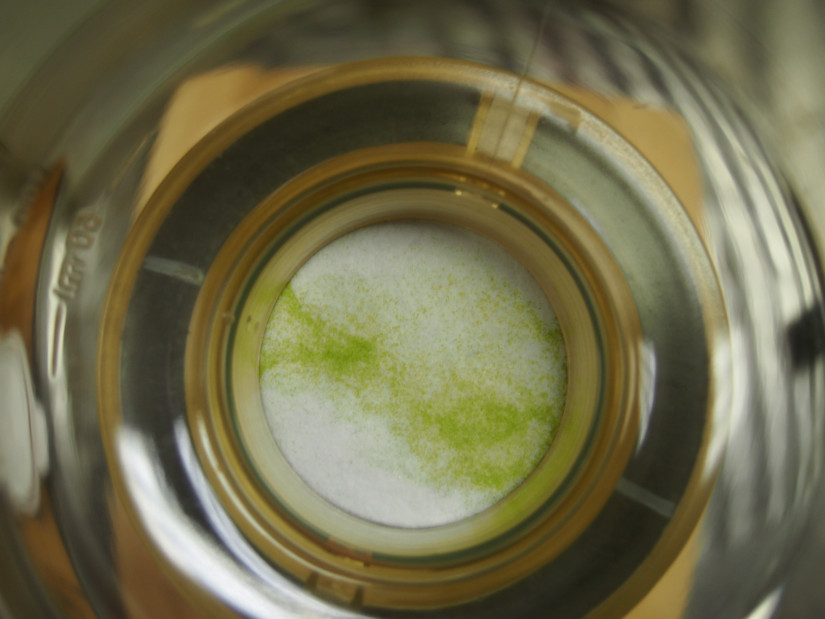
This photo is of disrupted cyanobacterial filaments on a filter. This water sample was collected at an ephemeral pan near the center of mass mortality.
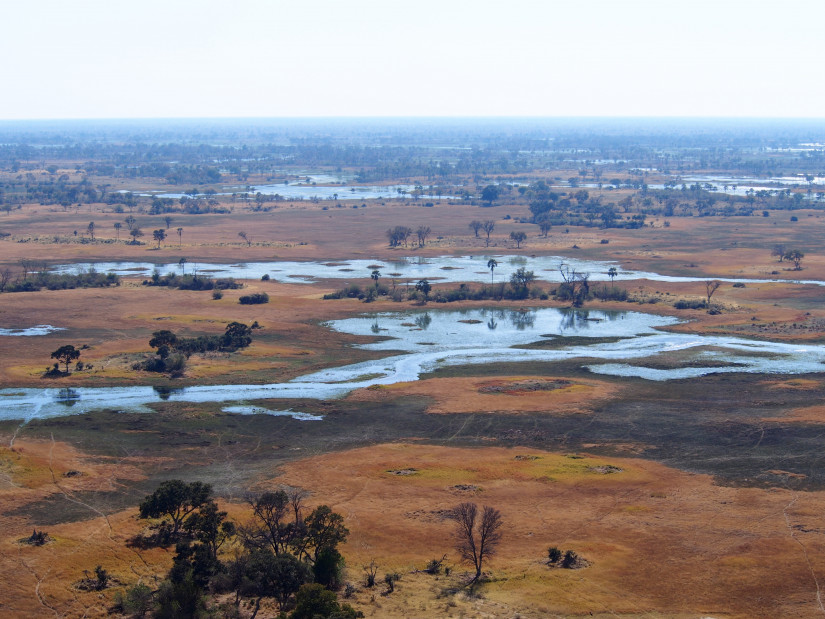
According to Lihini Aluwihare, the Okavango Delta is like no other place on Earth. In July it is beginning to fill while the rest of Botswana is amidst its dry season. The water that feeds the delta comes from a fair distance away.
About Scripps Oceanography
Scripps Institution of Oceanography at the University of California San Diego is one of the world’s most important centers for global earth science research and education. In its second century of discovery, Scripps scientists work to understand and protect the planet, and investigate our oceans, Earth, and atmosphere to find solutions to our greatest environmental challenges. Scripps offers unparalleled education and training for the next generation of scientific and environmental leaders through its undergraduate, master’s and doctoral programs. The institution also operates a fleet of four oceanographic research vessels, and is home to Birch Aquarium at Scripps, the public exploration center that welcomes 500,000 visitors each year.
About UC San Diego
At the University of California San Diego, we embrace a culture of exploration and experimentation. Established in 1960, UC San Diego has been shaped by exceptional scholars who aren’t afraid to look deeper, challenge expectations and redefine conventional wisdom. As one of the top 15 research universities in the world, we are driving innovation and change to advance society, propel economic growth and make our world a better place. Learn more at ucsd.edu.



